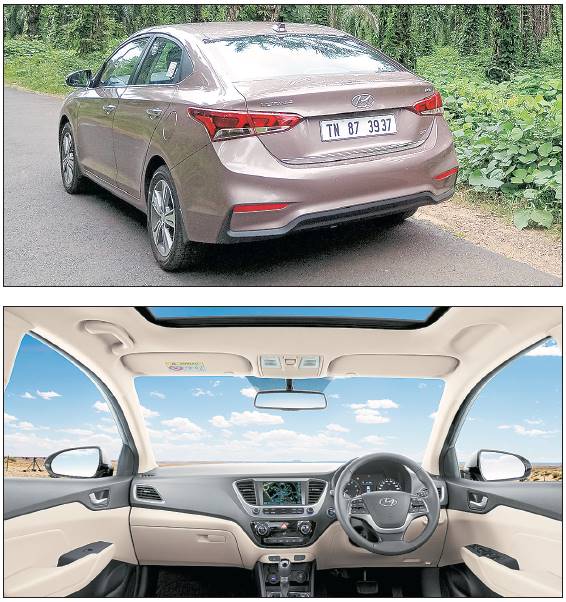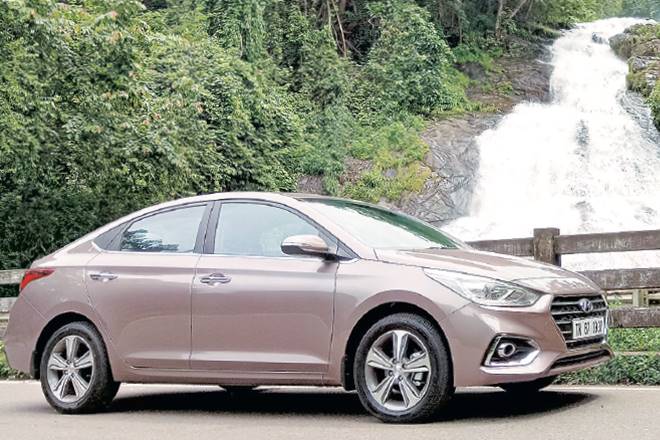It’s failure that gives you the proper perspective on success. Once India’s largest selling upper mid-size sedan, Hyundai Verna was humbled by better designed, and better equipped, Maruti Suzuki Ciaz and Honda City. Last week, the Korean car-maker launched the new generation of the Verna, and with it, some segment-first features that, the company believes, will help the car reach where it belongs – the top of the segment. We drive it in the hills around Kochi in Kerala.
Exterior
The Next Gen Verna has been developed on a bigger platform. The wheelbase is longer, which translates into more cabin space. An increased surface area on the outside makes the design lines look more dynamic and the car overall looks more elegant and proportionate. Key styling elements are the dual-tone rear bumper with black inserts, split-type LED tail-lamps with LED guides, shark-fin antenna, large 16-inch wheels, and a sloping roof line.
Interiors
The centre console, as is the case with most modern and premium cars, is driver-oriented. All controls are within easy reach. The AVN is a capacitive touchscreen, not resistive, so it’s very responsive, just like the screen of your smartphone. The car’s multimedia system is equipped with Apple Carplay, Android Auto and MirrorLink. The front seating area has very good space; the top-end variant we drove gets cooled seats, which is an amazing feature for Indian summers. The rear seating area, however, is not the best in segment, and tall people won’t be able to lounge around and relax. The rear has an AC though, and the seats provide decent support.

Technology
It’s loaded with technology. A feature we love is the Smart Trunk – just stand behind the trunk with the key in your pocket for three seconds, and the trunk will automatically open. It’s a feature usually found in very expensive cars. Then there is the Eco Coating technology that, the company says, prevents unpleasant odours to develop in the AC evaporator. Hyundai has introduced a connected car app with the new Verna, called Auto Link. It displays vehicle health, driving information, roadside assistance, driving history, eco driving behaviour and more on your smartphone screen. It’s a welcome new app and must be introduced for all Hyundai cars.
Drive
We drove the diesel variant, and it’s very powerful. The engine is the 1.6-litre U2 CRDi (1,582cc) that develops a peak power of 126bhp. It churns out 260Nm of juicy torque from just 1500rpm onwards, so as soon as you press the accelerator, the car shoots ahead. The Verna has been built on the new K2 platform that it shares with the Elantra, and that leads to better ride comfort. In fact, as far as sheer handling is concerned, the new Verna has massively improved over the previous generation. Also, NVH has been controlled and the diesel clatter just doesn’t enter the cabin.The petrol is the 1.6-litre Gamma Dual VTVT motor (1,591cc) that develops a peak power of 121bhp and a torque of 151Nm.
Both engines are available in manual and automatic six-speed transmission options. The claimed fuel-efficiency figures are:
• Petrol manual :17.7kpl
• Petrol automatic: 15.92kpl
• Diesel manual : 25.75kpl
• Diesel automatic: 21.02kpl
Verdict
The petrol is priced Rs 7.99 lakh to Rs 12.23 lakh, while the diesel is priced Rs 9.19 lakh to Rs 12.61 lakh (ex-showroom, Delhi), and these prices are only for the first 20,000 customers. Variant to variant, therefore, the Verna provides more value compared to rivals. It doesn’t have the best rear seats, but has the most powerful engines and its ride & handling is now at par with that of the City and Ciaz. If you love driving, the Verna should be your natural choice.


